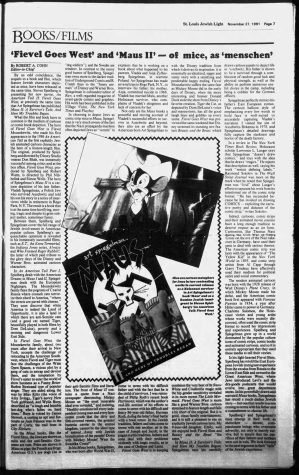Issue #2 “Proof that mice can roar”
Published February 2, 2022
The recent — and extraordinarily dumb — decision by a Tennessee school board to ban Art Spiegelman’s Pulitzer Prize-winning Holocaust-themed graphic novel “Maus” from its library is a reminder that mice cartoons have grown way beyond Mickey, Minnie, and even Mighty Mouse.
“Maus” is based on Spiegelman’s often painful interviews with his father, Vladik, a Polish Jewish Auschwitz survivor. Spiegelman’s father’s searing testimony is illustrated in comic book form whereby Jews are depicted as mice and Nazis are drawn as cats—an audacious use of the Tom and Jerry cartoon cat-and-mouse theme as a filter through which to see that which is beyond visualization.
Spiegelman and his father both suffered horribly from survivors’ guilt, the overwhelming depression that led Spiegelman’s mother, Anja Zylberberg Spiegelman, to take her own life in 1968. She was haunted by endless nightmares about her time in Auschwitz.
“Maus” was the first graphic novel to win a Pulitzer Prize in a special new category in 1992.
On Tuesday, Whoopi Goldberg was suspended from her talk show “The View” for two weeks and had issued a public apology after she said that “the Holocaust was not about race; it was about man’s inhumanity to man.”
Goldberg’s appalling statement was roundly denounced, and her apology was necessary. The Nazis considered Aryans to be the “Master Race” and Jews to be an “inferior race.”
As to what’s dumb about the Tennessee school board decision to ban a book published decades ago, there are many reasons, not the least of which is the fact that book burning was one of the early practices of Nazi Germany. There are chilling images of smiling Hitler youth gleefully burning books by Freud, Heine and Proust to “de-Judaize” Germany.
In addition, the banning of books at schools and libraries has swept up books like “The Diary of Anne Frank” because it contains references to her sexual awakening. Bans have also removed Harper Lee’s “To Kill a Mockingbird” from shelves despite the fact that her novel was among the very best American books ever published.
A contrastingly upbeat use of a Jewish mouse is in “An American Tail,” Steven Spielberg’s animated cartoon film about Fievel Mousekewitz, a tiny rodent separated from his Russian Jewish family as the ship docks in New York. Fievel finds that the streets of the Lower East Side are not “paved with cheese” as his parents had hoped. Fievel becomes street smart as he faces criminal gangs, sweat shops and the formation of the International Ladies Garment Workers Union.
 I reviewed both “Maus” and “An American Tail favorably at the time of their release and again in 1991 when sequels came out: “An American Tail II: Fievel Heads West” and “Maus II: A Survivor’s Tale” (click to read the 1986 and 1991 reviews).
I reviewed both “Maus” and “An American Tail favorably at the time of their release and again in 1991 when sequels came out: “An American Tail II: Fievel Heads West” and “Maus II: A Survivor’s Tale” (click to read the 1986 and 1991 reviews).
Here are two heavily contrasted stories — one about the dream of America and the other about the nightmare of Auschwitz — both illustrating their divergent themes through cartoon depictions of mice.
The decision of the short-sighted school board in Tennessee — the same state that banned the teaching of evolution — does a disservice to its students by insulting their intelligence. The banning of “Maus” had the opposite effect across America. Amazon reports that the book jumped to the top of its bestseller list. Talk about poetic justice.
Sometimes we get proof that mice can indeed roar.


















